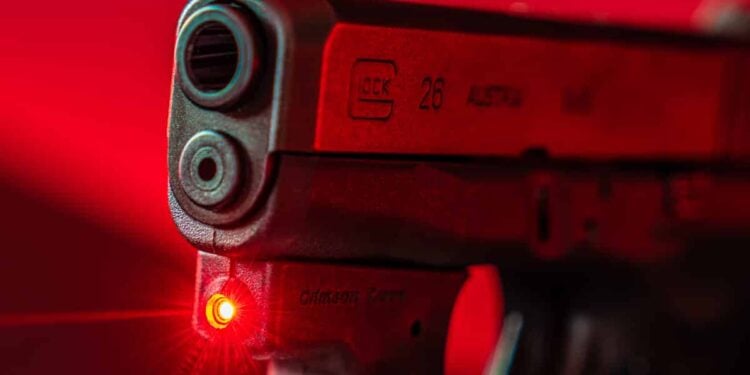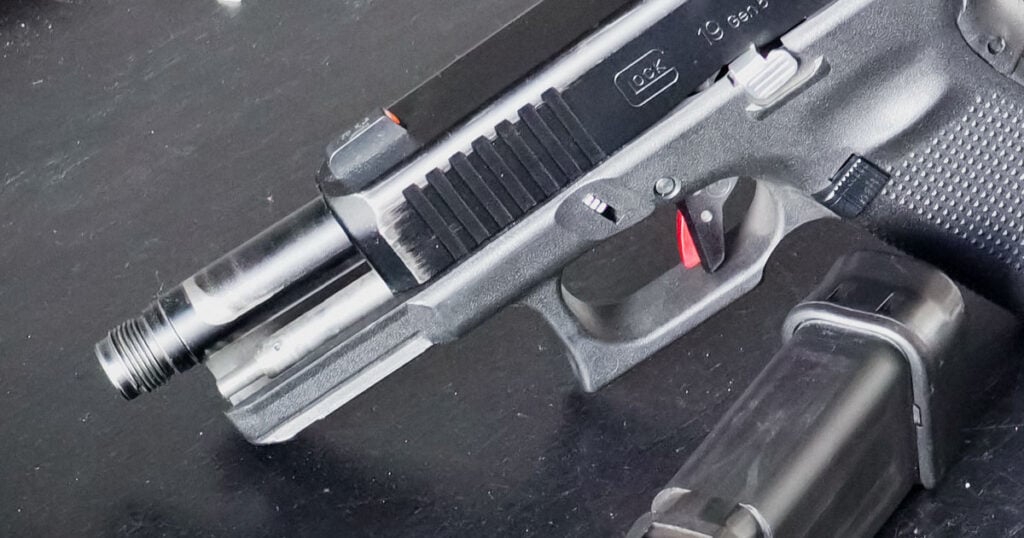Plenty of articles recommend that we use various accessories to make our carry guns more effective, and many of them can be beneficial when stress is high, and things are moving fast. I’m not talking about internal modifications like a lighter trigger, I’m referring to external gun gear like lights, red dots, lasers, and compensators. But as the saying goes, everything comes with a price, and there are some definite trade-offs attached to every piece of gun gear we add to our EDC. The intent of this article isn’t to tell you which accessories are good or bad; I have some of them on my own handguns; it’s simply to discuss the pros and cons of each.
The Questions
The first thing anyone should ask themselves before they add something to their everyday carry gun is why. Why do I need this on my handgun? How will it improve my performance in a crisis? What are the potential drawbacks, and do they outweigh the benefits? It pays to look at both sides of the equation before installing any external accessory to your EDC gun.
Weapon-Mounted Lights
Weapon-mounted lights, WMLs, are an established accessory for all types of guns. They have their place to be sure, and I have a light on my home defense handgun, AR, and shotgun. But what about on an everyday carry gun? They have some clear benefits.
For one, a WML is quick to deploy. When you draw your gun, the light comes with it; you do not have to use your other hand to find your light in a pocket or belt carrier. It also enables you to keep a proper two-handed grip on your handgun rather than having to hold a flashlight. Plus, your support hand is free to do other things like open a door or turn on a light switch. Finally, you know that your light and muzzle are always pointed at the same spot, making target acquisition much surer in the dark.
On the other hand, the last benefit mentioned above is also a major drawback. To point your light at something, you must point your gun at it. That is not ideal if you are looking for the source of a sound in a dark parking lot or trying to identify the silhouette of a person who could be an assailant or an innocent bystander. WMLs also add bulk and weight to the front of your handgun. While some people feel that the extra weight helps to tame recoil, it does change the balance of your gun. One of the most often heard criticisms of WMLs is largely a problem based on poor technique: that they give away your position. Yes, they can if you walk around with the light on all the time. The proper technique is to use it intermittently, moving between turning it off and on. Finally, guns with WMLs require a specially designed holster, adding extra expense to your EDC set-up.
Pros:
• Provides a ready light source in low light and dark conditions
• Quick to deploy
• Having the light mounted on the gun allows for a two-hand grip
• Frees the support hand to do other things like open doors
• Always puts light on the exact spot the gun is pointing
Cons:
• Adds weight and bulk to the front of the handgun
• Requires a holster designed for guns with lights
• Anything you point the light at also has your gun pointing at it


Red Dots
Red dot optics enable you to rapidly acquire your target because you do not have to align your sights. As long as your optic is properly zeroed, all that you must do is get the dot on the target and pull the trigger. They are especially useful in poor lighting. There is a valid reason the military has gone to optics for its infantry rifles. Red dots are also becoming more popular for EDC handguns. Most models feature a shake-to-activate function that eliminates the need to actively turn them on when presenting your gun. They also automatically shut off when not in use to save battery life. They are particularly good for people with vision problems.
The biggest drawback of a red dot is its added bulk, which frequently requires a special holster for concealed carry. As with any battery-powered device, the battery can fail, although optic batteries generally last thousands of hours. There is a learning curve with a red dot, so the shooter can learn the best way to look through it to acquire the dot quickly. Good trigger technique remains a must to get accurate hits. Finally, red dots can be expensive, in some cases costing as much as the handgun itself.
Pros:
• Quick target acquisition
• Excellent for low-light conditions
• Great for people with vision problems that make acquiring iron sights difficult
Cons:
• Can be expensive
• Take some practice to learn to acquire the dot quickly
• Most rely on batteries that can fail
• Adds some bulk to the gun
• Require a special holster
• Do not replace good training and target acquisition skills


Lasers
Everybody has seen an action movie where someone is standing with a laser dot on their forehead informing the viewer they are about to be shot. Dramatic but accurate. At shorter ranges, a laser allows for very fast target acquisition. They are especially useful when shooting from cover in an awkward position that makes aligning your eyes with your sights for a good sight picture difficult. They are also useful for anyone with vision problems. I had some eye surgery a couple of years ago, so I mounted a laser on one of my handguns to provide a little boost during my recovery period.
On the downside, lasers have a more limited range than a red dot, and the laser dot can be difficult to see in bright sunlight. Many are only visible a few yards away in daylight, although green lasers tend to be easier to see in bright light than red lasers. They add some bulk to your gun and may require a special holster for EDC. As with any battery-powered device, you must ensure the battery is good each time before you go out. Finally, just as with an optic, good trigger technique is still the most important factor in keeping your shots on target under pressure.
Pros:
• Fast target acquisition without the need to align sights
• Great for people with poor vision
• Good for use from cover where it might be difficult to get a sight picture
Cons:
• Limited range and can be difficult to see in bright light
• Some models add bulk and weight to the front of the gun
• May require a special holster
• Must be zeroed accurately
• Do not replace training and proper trigger pull technique


Compensator
A compensator may seem like an odd addition to an everyday carry gun, but they are becoming more popular. Many manufacturers are innovating compact compensators like the Griffin Armament Micro Carry Comp, which reduces bulk while still offering the advantages of a compensator. Those advantages include reduced recoil and muzzle flip, making it easier to get accurate follow-up shots during rapid fire.
The greatest drawback of compensators is the length they add to your barrel. Even the micro models add some length, which can potentially make maneuvering the gun during your draw and reholstering a bit more challenging. They also increase noise for the shooter. Finally, they require the addition of a threaded barrel. That means that when they are not installed, you should use a thread protector on the barrel to protect the threads.
Pros:
• Reduce felt recoil
• Reduced muzzle flip during rapid-fire
Cons:
• Add length and weight to the barrel
• Require a threaded barrel
• Can reduce concealability
• Maneuverability when holstering can be a challenge


Threaded Barrels
More and more handgun models with threaded barrels are being offered. This is because suppressors are in vogue these days, so everyone wants a cool tactical gun that is suppressor-ready. The advantage of a threaded barrel is the ease with which you can add a suppressor or compensator.
However, if you have no plans to add a suppressor or compensator, there is really no need for a threaded barrel. It will just add unnecessary length to your handgun, and there is always the danger of the thread protector coming loose and getting lost.
Pros:
• Allow installation of suppressors and compensators
Cons:
• Adds extra length to the barrel
• Thread protectors can come loose and get lost
Conclusion
Gear for your everyday carry handgun can offer some definite advantages. But, as with everything in life, it’s important to weigh the advantages against the disadvantages. In most cases, depending on your reason and what you are hoping to achieve, the benefits usually outweigh the drawbacks. Nevertheless, it’s a good idea to consider the pros and cons before laying your money down for an accessory you may not be happy with in the long run.
Read the full article here





